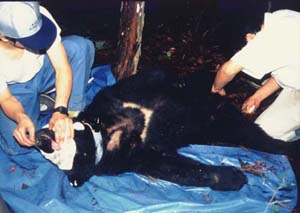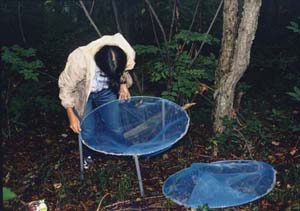 Objectives of
the Research
Objectives of
the Research
What we wish to do is to explore and propose an
adequate bear management plan that will enable man and bear to continue
their coexistence. This objective will be achieved through analysis and
evaluation of the living mode and environment of black bears in Okutama
Mountains in Tokyo.
Period of the Survey: Begun in 1992, it is ongoing.
Target Area: Our survey covers all the habitable areas
of 550 square
kilometers, but a particular emphasis is put on the
rims of Lake Okutama. The
items of our survey are extensive, so allow us to
list up main items.
 Capture
Capture
Capturing it alive, we measure the bear's body weight,
sample its tissue and/or blood, and attach a radio-wave transmitting collar

Photo: Weighing an adult male (74 kg, 11.5 years of
age). The black bears in Tokyo are considered smaller than those
in Tohoku and Hokkaido.
 Radio telemetry
Radio telemetry
We track the roaming paths of the radio-attached bear
and look into its life patterns.
 A
snapshot from radio-telemetry tracking
A
snapshot from radio-telemetry tracking
Photo: Locating the hibernation den of the radio-tracked
bear. The directional antenna points to the bear's hideout.
 Survey of food
items
Survey of food
items
Acorns serve as a principal food for bears in autumn.
We examine the annual yield of acorns as well as its variation from year
to year.

Photo: A seed-trap is being mounted for quantitatively
estimating the
number of Konara oak(Quercus serrata), Mizunara oak(Quercus
crispula), Chenuts that have bore fruit.
About 250 traps have been set up in the mountains
at present.
 A scene of scat
sampling
A scene of scat
sampling
Analyzing the contents of bear scat allows us to guess
the types of food the bears eat and how they vary over a year.

A
snapshot from radio-telemetry tracking